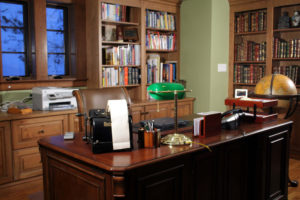 Years ago I was representing a screenwriter before an IRS audit. We did not prepare the
Years ago I was representing a screenwriter before an IRS audit. We did not prepare the
return but was defending our client’s home office deduction in a place that the client no longer lived, or had pictures. The agent baulked on allowing the deduction due to the lack of verifiable facts. I then leaned closer to the female auditor and told her that this client had written the screen play of a famous Disney animated movie in that very same home office. The auditor teared up and said, “My daughter loved that movie!”
We got the full deduction.
The IRS just waived a magic wand by listing some tips on the new law that offers an easier way to deduct a home office without substantiating expenses. Here are the facts:
This simplified option does not change the rules for who may claim a home
office deduction. It merely simplifies the calculation and recordkeeping
requirements. The new option can save you a lot of time and will require less
paperwork and recordkeeping.
Here are six facts the IRS wants you to know about the new, simplified
method to claim the home office deduction.
1. You may use the simplified method when you file your 2013 tax return
next year. If you use this method to claim the home office deduction, you will
not need to calculate your deduction based on actual expenses. You may instead
multiply the square footage of your home office by a prescribed rate.
2. The rate is $5 per square foot of the part of your home used for
business. The maximum footage allowed is 300 square feet. This means the most
you can deduct using the new method is $1,500 per year.
3. You may choose either the simplified method or the actual expense
method for any tax year. Once you use a method for a specific tax year, you
cannot later change to the other method for that same year.
4. If you use the simplified method and you own your home, you cannot
depreciate your home office. You can still deduct other qualified home
expenses, such as mortgage interest and real estate taxes. You will not need to
allocate these expenses between personal and business use. This allocation is required
if you use the actual expense method. You’ll claim these deductions on Schedule
A, Itemized Deductions.
5. You can still fully deduct business expenses that are unrelated to
the home if you use the simplified method. These may include costs such as
advertising, supplies and wages paid to employees.
6. If you use more than one home with a qualified home office in the
same year, you can use the simplified method for only one in that year.
However, you may use the simplified method for one and actual expenses for any
others in that year.
______________________________________________________________________________
IRS CIRCULAR 230 NOTICE: To ensure compliance with requirements imposed by the U.S. Department of the Treasury and Internal Revenue Service, we inform you that any
tax advice contained in this e-mail (including any attachments) is not intended
or written to be used, and may not be used, for the purpose of (a) avoiding
penalties under the Internal Revenue Code or state tax authority, or (b)
promoting, marketing, or recommending to another party any transaction or
matter addressed herein.

 Do you use “vertical” logic to solve a problem? This classic method for problem solving works out a solutions using a step-by-step method until a person arrives at a conclusion. Engineers I’ve known, have used this approach.
Do you use “vertical” logic to solve a problem? This classic method for problem solving works out a solutions using a step-by-step method until a person arrives at a conclusion. Engineers I’ve known, have used this approach.
 When I started playing guitar in the early 1960s, nobody played “air guitar.” Those who didn’t want to play, didn’t, and those who wanted to play guitar copied Jimmy Hendricks, Chuck Berry, and many others in the entertainment industry.
When I started playing guitar in the early 1960s, nobody played “air guitar.” Those who didn’t want to play, didn’t, and those who wanted to play guitar copied Jimmy Hendricks, Chuck Berry, and many others in the entertainment industry. I remember about six years ago when a relatively unknown organization, Soundexchange, contacted us (CPA entertainment business managers) about signing up one of our music artist clients. They said that our client was not collecting all music royalties through ASCAP, UMG, EMI, etc. Instead, there were an increasing amount of royalties being left on the table from certain digital transmissions like streaming.
I remember about six years ago when a relatively unknown organization, Soundexchange, contacted us (CPA entertainment business managers) about signing up one of our music artist clients. They said that our client was not collecting all music royalties through ASCAP, UMG, EMI, etc. Instead, there were an increasing amount of royalties being left on the table from certain digital transmissions like streaming. I was twenty-one in 1978 when I got my first part-time CPA accounting job while studying at UCLA. The adding machine I used had a crank…really.
I was twenty-one in 1978 when I got my first part-time CPA accounting job while studying at UCLA. The adding machine I used had a crank…really. My father sang rockabilly in the 1950s under contract with Capitol Records. (
My father sang rockabilly in the 1950s under contract with Capitol Records. ( Tomorrow, as a Los Angeles CPA business manager, I will be merging two of my skills with a client. My entertainment business management skills, and my strategic planning skills. This client is a singer/songwriter who produced a music demo and video. My question to her was, “So what?” If you pursue the path of other musicians to acquire a contract, a 360 deal, you are no better than them, and may be just one of many homogeneous artists trying to make it.
Tomorrow, as a Los Angeles CPA business manager, I will be merging two of my skills with a client. My entertainment business management skills, and my strategic planning skills. This client is a singer/songwriter who produced a music demo and video. My question to her was, “So what?” If you pursue the path of other musicians to acquire a contract, a 360 deal, you are no better than them, and may be just one of many homogeneous artists trying to make it. Many articles surfaced earlier this year about Jeff Bridge’s crossing over to country music. Some were not flattering. For example,
Many articles surfaced earlier this year about Jeff Bridge’s crossing over to country music. Some were not flattering. For example,  Business plans are very familiar to me. I receive calls from time to time to design one for individuals who have potential investors. In doing so, I try to incorporate some form of a strategic plan in the product because new entrepreneurs rarely think on that level.
Business plans are very familiar to me. I receive calls from time to time to design one for individuals who have potential investors. In doing so, I try to incorporate some form of a strategic plan in the product because new entrepreneurs rarely think on that level. Back in the day…music from TV crossed onto the charts. Remember Hawaii 5-0, Mannix, Peter Gunn, Mission Impossible, and Magnum PI? I don’t know if there was a strategy to cross over, but you don’t see this type of proliferation of TV music today. Instead, some of the highest rated programs are using music from the 1960s and 1970s. For example, The Who’s music on CSI: Miami.
Back in the day…music from TV crossed onto the charts. Remember Hawaii 5-0, Mannix, Peter Gunn, Mission Impossible, and Magnum PI? I don’t know if there was a strategy to cross over, but you don’t see this type of proliferation of TV music today. Instead, some of the highest rated programs are using music from the 1960s and 1970s. For example, The Who’s music on CSI: Miami.